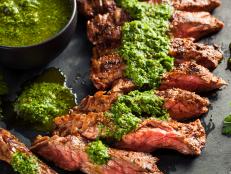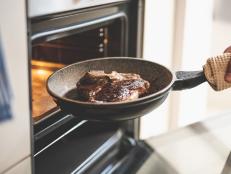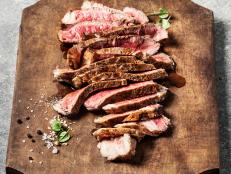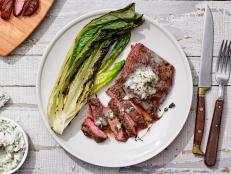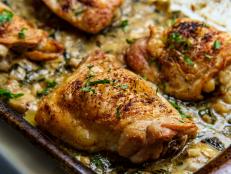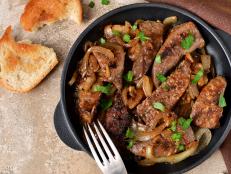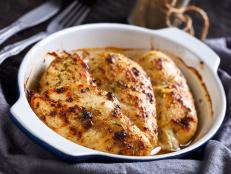How to Cook Steak on the Stove
Step 1: Choose a thin, boneless cut of a steak.

Eugene Mymrin/Getty Images
By Layla Khoury-Hanold for Food Network Kitchen
Layla Khoury-Hanold is a contributor at Food Network.
What to do when you’re craving a steak, but you don’t have time to fire up the grill, or it’s too hot to turn on the oven? Cook it stove-top! Cooking a steak on the stove is a sure-fire way to satisfy your steak craving, whether it’s a weeknight dinner or special occasion supper. Here, we share our top tips and techniques for cooking steakhouse-worthy steaks on the stove, plus how long you need to cook it to achieve desired doneness. And the best part? No fancy equipment or grill required.
What You’ll Need to Cook Steak on the Stove
The Right Cut of Steak
- Thin cuts: Because cooking steaks on the stove is a fast process, you’ll want to opt for thinner steaks that are between 1 and 1 1/2 inches thick. Steaks with thickness above 1 1/2 inches require oven time to finishing cooking. Cuts that are less than 1-inch, such as flank or flat-iron steaks, can also be cooked using the stove-top method, but keep in mind that they’ll cook much faster than other boneless cuts and often benefit from a marinade to help break down tough connective tissue and fibers.
- Boneless: Look for boneless cuts; bone-in cuts take longer to cook and are therefore better suited to grilling or finishing in the oven.
- Good Marbling: Cuts with good marbling, the streaks of white fat that run throughout the meat, are well-suited to cooking on the stovetop. The marbling imparts flavor and helps keep the steak juicy as it cooks. Examples include ribeye or New York strip. Filet mignon also lend themselves well to this cooking application.
The Right Tools
You’ll need a heavy-bottomed skillet, such as cast-iron or stainless steel; tongs; instant-read thermometer
How to Cook a Steak on the Stove
Bacon Fat Basted Steak
The next time you're cooking bacon, whatever you do, don't toss the fat! Instead, let it cool down in the pan, then strain it through a coffee filter into an airtight container. Stash it in the refrigerator and use a few tablespoons to baste steak on the stovetop to impart richness and a subtle bacon-y flavor.
1. Remove Steak from the Refrigerator 30 Minutes Before Cooking
To ensure that your steak cooks evenly and all the way through, remove your steak from the refrigerator 30 minutes prior to cooking. If the steak is too cold, you risk overcooking the outside and undercooking the inside.
2. Dry Off the Steak
To ensure proper browning, pat your steak dry with a paper towel before seasoning. This prevents the salt from melting and stops steam from forming when the steak hits the pan, which is key for obtaining a nice sear and a deep brown, flavorful crust.
3. Oil and Season the Steak
Once the steak has been patted dry, brush it with a bit of olive oil and season it with a generous sprinkling of kosher salt and freshly ground black pepper on all sides.
4. Heat the Pan Over High Heat
Heat a large, heavy-bottomed skillet over high heat. A cast iron pan is the preferred skillet of choice, owing to its ability to retain even heat distribution, which is ideal for promoting even cooking and crust formation. You can also use a stainless-steel pan, which some people prefer for scraping up the fond (the cooked brown proteins that stick to the bottom of the pan) to make a pan sauce.
5. Sear the First Side
If the steak has a fat cap, sear that side first; you won't need any additional oil in the pan. Place the steak flat in the skillet and sear until deep brown on one side, 4 to 5 minutes. Resist the urge to poke and turn the steak. You'll know it's time to flip when you can move it freely in the pan. If it sticks to the bottom, it's not ready to turn.
6. Sear the Second Side
Turn and cook the other side until starting to brown, 2 to 3 more minutes. During the last minute of cooking, add a dollop of butter to the skillet along with aromatics and herbs, such as fresh rosemary and crushed garlic cloves, to the skillet. Continue cooking the steak, tilting the skillet every so often and spooning the infused melted butter over the top of the steak, until a thermometer inserted sideways into the thickest part registers 120 degrees F for medium rare .
7. Rest and Serve the Steak
Transfer steak to a cutting board, loosely cover with aluminum foil and let rest 10 minutes. This allows the juices to redistribute evenly and ensures that steak retains its juices when you slice into it. Slice the steak against the grain and serve with pan drippings/basting butter or with pan sauce.
8. How Long to Cook Steak on the Stove
How long you need to cook your steak will depend on how thick the steak is and your desired doneness. The most accurate way to determine when your steak is done cooking is to use an instant-read thermometer. Keep in mind that your steak will come up 5 to 10 degrees while resting, so you’ll want to pull your steak a little bit before it reaches its final temperature. You can start checking for doneness halfway through cooking to determine how much longer the second side needs to cook. Here’s a range of internal temperatures for achieving various doneness preferences*:
Rare: 125 degrees F (about 6 minutes total cooking time)
Medium-Rare: 130 to 135 degrees F (about 7 to 8 minutes total cooking time)
Medium: 135 to 140 degrees F (about 9 to 10 minutes total cooking time)
Medium-Well: 140 to 150 degrees F (about 10 minutes total cooking time)
Well-Done: 155 degrees F (about 12 minutes total cooking time)
*These temperatures are considered safe by many chefs and cooking experts. Nonetheless, extra caution must be exercised when cooking for at-risk groups, particularly the elderly, children under 7 and the immuno-compromised. In such cases, we suggest the USDA guidelines of cooking steak to at least 145 degrees F plus a 3-minute rest be strictly followed.
Related Links:
























